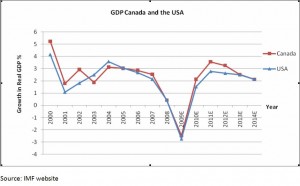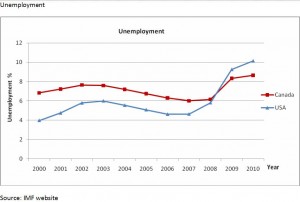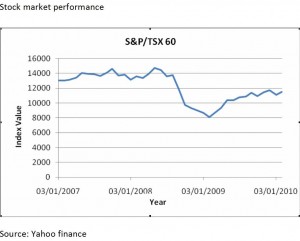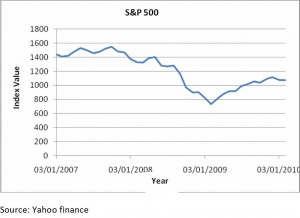A recession is a general downturn in the economy, a contraction of the business cycle.
It is generally defined as a decline in GDP for two consecutive quarters. The National Bureau of Economic Research (NBER) in USA defines an economic recession as: “a significant decline in economic activity spread across the country, lasting more than a few months, normally visible in real GDP growth, real personal income, employment (non-farm payrolls), industrial production, and wholesale-retail sales.”
As the most recent recession showed us people lose jobs, home prices fall, demand declines, production dips, stocks lose value and the collective mood of the populace takes a down turn As the NBER defines it, the most recent recession started in December 2007 but is it over yet? We will look at some key indicators to see where we stand now.

As the chart illustrates, growth in real GDP is expected to be positive in 2010. The IMF forecasts 2.125% real GDP growth in Canada and 1.518% in the USA. A survey carried out by the Federal Reserve Bank of Philadelphia forecasts the US economy will expand at an annualized rate of 2.7% in the next five quarters.
Unfortunately the unemployment rate is set to be 8.647% in Canada and 10.146% in the USA in 2010. According to Statistics Canada, Canadian employment in part time employment increased by 43,000 in January 2010 reducing the unemployment rate by 0.1%. However, the employment number still stands 280,000 below the October 2008 level. There are mixed indications in the USA. According to the latest data from the Bureau of Labour Statistics USA, the unemployment rate fell to a five month low of 9.7% in January 2010 though employers unexpectedly cut 20,000 jobs in January. In further signs of labour market improvement the average workweek increased to 33.3 hours in January 2010 from 33.2 hours in the preceding month. The average hourly earnings increased from USD 18.84 to USD 18.89 during the same period.
Consumer spending
The Global Forecast Update by Scotia Economics forecasts a 3% growth in Canadian consumer spending and 2.1% growth in the USA.
Rising unemployment and job insecurity coupled with worries about the economy are likely to dampen growth in consumer spending in the USA.
Meanwhile Mark Carney, the governor of the Bank of Canada said consumers would be at the “heart” of the economic recovery in Canada. Consumer spending is expected to contribute half of the growth in final domestic demand in 2010.
As the charts indicate it looks as if the worst is over for the stock markets.
Home prices
The Teranet-National Bank Composite House Price Index, which measures price changes for repeat sales of single-family homes, showed overall prices were up 0.8 percent in November from October 2009. This is the seventh straight month prices have increased. The home prices are actually close to their 2008 high and have analysts worried about a possible bubble.
On the other hand the recovery in the USA is going to be weak. The chief economist of Fannie Mae stated recently that the decline in home prices is not over yet. Tight credit and extra cautious consumers wary of borrowing are not likely to help the situation.
Increasing interest rates are another indication of economic recovery. The Bank of Canada and the US Federal Reserve both seem set to retain the current rates till at least the 3rd quarter of 2010.
While most indicators seem positive home prices and unemployment in the USA may actually deteriorate before turning around. We are not at the bottom anymore but we are not out of the woods yet either.












